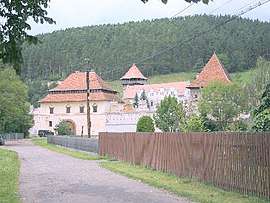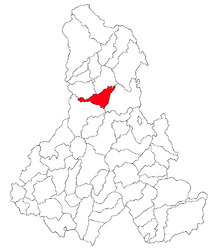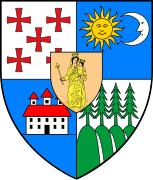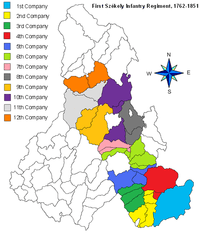Lăzarea
Lăzarea (Hungarian: Gyergyószárhegy or colloquially Szárhegy, Hungarian pronunciation: [ˈɟɛrɟoːsaːrhɛɟ], meaning Bold Mountain in Gyergyó) is a commune in Harghita County, Romania. It lies in the Székely Land, an ethno-cultural region in eastern Transylvania, and is composed of two villages:
- Ghiduț / Güdüc
- Lăzarea / Gyergyószárhegy
Lăzarea Gyergyószárhegy | |
|---|---|
 The Lázár Castle | |
 Coat of arms | |
 Location in Harghita County | |
 Lăzarea Location in Romania | |
| Coordinates: 46°45′N 25°32′E | |
| Country | |
| County | Harghita |
| Government | |
| • Mayor | Gábor László[1] (UDMR) |
| Area | 80.88 km2 (31.23 sq mi) |
| Population (2011)[2] | 3,424 |
| • Density | 42/km2 (110/sq mi) |
| Time zone | EET/EEST (UTC+2/+3) |
| Postal code | 537135 |
| Area code | +40 266 |
| Vehicle reg. | HR |
It is one of the oldest settlements in the area, and is now a tourist and cultural centre. It has various local attractions, including the Lázár [3] castle (1450).
History
The history of the village is closely interwoven with that of the Lázár family.
Its first written mention is from 1482 when a certain Erzsébet Bíró of Kide warned a Székely named Lázár of Zarhegh and Péter Szilvási to beware of disposing of the estate of Kide to which she was entitled under the title of bride price and dower. In 1576, its name was recorded as Szárhegy, in 1888 as Gyergyó-Szárhegy. Its original Romanian name derived from the Hungarian Gyergyószárhegy as Giugeu-Sarheghi which was modified to the current official name after 1918.[4]
It belonged administratively to the Székely seat of Gyergyószék, subsequently absorbed into Csíkszék district, until the administrative reform of Transylvania in 1876, when it fell within Csík County in the Kingdom of Hungary. After the Treaty of Trianon of 1920, it became part of Romania and fell within Ciuc County during the interwar period. In 1940, the second Vienna Award granted the Northern Transylvania to Hungary and the village was held by Hungary until 1944. After Soviet occupation, the Romanian administration returned and the commune became officially part of Romania in 1947. Between 1952 and 1960, the commune fell within the Hungarian Autonomous Province, between 1960 and 1968 the Mureș-Hungarian Autonomous Province. In 1968, the province was abolished, and since then, the commune has been part of Harghita County.
Demographics
The commune has an absolute Székely (Hungarian) majority. According to the 2011 census it has a population of 3,395; of which 97.23% or 3,301 are Hungarian.
The Lázár Castle
The Lázár Castle was built between 1450 and 1532 in several stages. In the late 16th century, Druzsina, daughter of István Lázár married Farkas Bethlen of Iktár, and to this marriage was born the future prince of Transylvania Gabriel Bethlen. He was brought up in the castle and his upstairs room in the gate tower can still be seen unto this day. In 1631, the castle was expanded and altered into a magnificent Renaissance manor house, towers and curtain walls were also built. It became one of the important military and administrative centers of the Székely Land. On September 6, 1658, a team of Szeklers led by a student named Gábor Székely defeated the invading Tatars and Moldovans. The dead were buried on a hill below the village which is called until today Tatarhill. A plaque was put up in 1908 in memory of the battle. The Szekely Land was often hit by Ottoman invasions and on one occasion, the castle was seriously damaged. During the Hungarian war of independence of Ferenc II Rákóczi, Ferenc Lázár supported the operations of the kuruc troops. In 1707, when the imperial army marched into Transylvania, Ferenc Lázár had to flee to Csángós to Moldova. Imperial general Acton set fire to the castle and only a bastion remained intact. After the Peace of Szatmár, Ferenc Lazár pledged allegiance to the Habsburg Emperor and thus was able to keep his estates. When the castle was burned down again in 1748, the family, was not able any more to restore all parts of it, and what was restored was made partly from donations of the villagers. Finally in 1842, it was almost completely destroyed by another fire. In the 19th century, the financial status of the Lázár family started to deteriorate and only the gate tower remained suitable for habitation. After last Lázár heir, Zsigmond and his wife, left the castle in 1853, it fell even further into decay.
Nowadays, much of the castle has been renovated. Renovation of the renaissance murals started in 1987 with the help of UNESCO.
Landmarks
- The Lázár Castle
- The Franciscan monastery
- The Roman Catholic parish church
- The Saint Anthony chapel
- The "Sculpture Park"
Notable people
- Johannes Caioni, 17th century architect, musician and humanist lived and worked in the village.
- János Koós, Hungarian singer and actor was born here in 1937.
Twinnings
The commune is twinned with:







.svg.png)

References
- (in Romanian) alegeri.tv - Alegeri locale 2012 - Rezultate alegeri Primăria Lăzarea, judeţul Harghita Archived 2016-06-16 at the Wayback Machine; retrieved on March 29, 2013
- "Populaţia stabilă pe judeţe, municipii, oraşe şi localităti componenete la RPL_2011" (in Romanian). National Institute of Statistics. Retrieved 4 February 2014.
- Lázár Castle
- János András Vistai. "Tekintő – Erdélyi Helynévkönyv". Missing or empty
|url=(help)Transylvanian Toponym Book Archived 2011-07-10 at the Wayback Machine
External links
| Wikimedia Commons has media related to Lăzarea, Harghita. |

